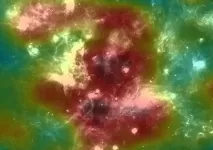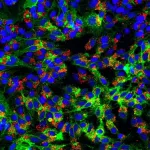(Press-News.org) Fossil sites sometimes resemble a living room table on which half a dozen different jigsaw puzzles have been dumped: It is often difficult to say which bone belongs to which animal. Together with colleagues from Switzerland, researchers from the University of Bonn have now presented a method that allows a more certain answer to this question. Their results are published in the journal Palaeontologia Electronica.
Fossilized dinosaur bones are relatively rare. But if any are found, it is often in large quantities. "Many sites contain the remains of dozens of animals," explains Prof. Dr. Martin Sander from the Institute of Geosciences at the University of Bonn.
If the finder is lucky, the bones are still arranged exactly as in the living dinosaur. Some are even still connected to each other at their joints. All too often, however, they were pulled apart and dispersed by scavengers and flowing water before being embedded in the soil. "Assigning this pile of hundreds of fossilized bones to the respective individuals from which they originally came is then usually very difficult," stresses Sander, who is also a member of the transdisciplinary research area "Building Blocks of Matter and Fundamental Interactions".
This is because, for one thing, "long bones" from the arms and legs, like the thigh bone, look remarkably similar even in different species. This means that even experts are often unable to say whether a fossil thigh bone is from Diplodocus or Brachiosaurus. And even if this could be ascertained, perhaps the excavation produced several Diplodocus specimens to which it could belong.
Sander and his doctoral student Kayleigh Wiersma-Weyand have now been able to demonstrate how this can be achieved. They used dinosaur bones from the U.S. state of Wyoming as a test object. These had been excavated and partially combined into skeletons by a team from the Aathal dinosaur museum in Switzerland shortly before the turn of the millennium.
Drilling into 150 million year old bones
The Swiss researchers made their finds available to the paleontologists in Bonn for the study. Wiersma-Weyand and Sander drilled into the 150-million-year-old bones and examined the extracted core under the microscope. "This allows us to find out how old the animal in question was when it died," Wiersma-Weyand explains. For one thing, young bones are better vascularized than old ones; this means that after fossilization they have more cavities in which the blood vessels used to be. Second, bone growth proceeds in spurts. "We therefore often see characteristic annual rings, similar to what we see in trees," the researcher says.
Estimating the age often makes it possible to rule out that a bone belongs to a particular skeleton. "If the left thigh bone is ten years older than the right one, we have a problem," Sander says laconically. There were no such discrepancies in the finds examined for the study. "However, we came across bones that had previously been attributed to two different animals, but probably belong to one and the same skeleton."
The study addresses a problem that has begun to come into scientific focus in recent years: With many mounted dinosaur skeletons located in museums and collections around the world, it is still not clear whether their bones come from one or more individuals. This combination is often done deliberately during mounting, since dinosaur skeletons are rarely preserved in their entirety. Supplementing missing bones with finds from other specimens is therefore common practice and, in principle, not a big deal as long as it is recorded. More critical, however, is when researchers combine finds unknowingly and these then come from different species or animals of different ages.
When the original Diplodocus has legs that are too short
This becomes particularly relevant when the skeletons are so-called type specimens. This is because these are considered the "standard" for the corresponding species, similar to the prototype meter. But what if, for example, the original Diplodocus contains the lower legs of a younger (and thus smaller) Diplodocus specimen? "Then some of the conclusions we draw about its locomotion and lifestyle may be wrong," Sander points out. "Our research therefore also helps combat the much-cited replication crisis in science."
Together with Kayleigh Wiersma-Weyand and Master student Nico Roccazzella, he will soon be using this method to take a closer look at a famous exhibit: the "Arapahoe" skeleton, the longest skeleton of a dinosaur in Europe, which is currently on display at the Museum Koenig in Bonn.
INFORMATION:
Publication: Kayleigh Wiersma-Weyand, Aurore Canoville, Hans-Jakob Siber and Martin P. Sander: Testing hypothesis of skeletal unity using bone histology: The case of the sauropod remains from the Howe-Stephens and Howe Scott quarries (Morrison Formation, Wyoming, USA); Palaeontologia Electronica; DOI: https://doi.org/10.26879/766
Contact:
Prof. Dr. Martin P. Sander
Institut für Geowissenschaften
Universität Bonn
Tel. +49-(0)228-733105
E-mail: martin.sander@uni-bonn.de
For the first time ever, a Northwestern University-led research team has peered inside a human cell to view a multi-subunit machine responsible for regulating gene expression.
Called the Mediator-bound pre-initiation complex (Med-PIC), the structure is a key player in determining which genes are activated and which are suppressed. Mediator helps position the rest of the complex -- RNA polymerase II and the general transcription factors -- at the beginning of genes that the cell wants to transcribe.
The researchers visualized the complex in high resolution using cryogenic electron microscopy (cryo-EM), ...
Magnetic resonance imaging (MRI) is already widely used in medicine for diagnostic purposes. Hyperpolarized MRI is a more recent development and its research and application potential has yet to be fully explored. Researchers at Johannes Gutenberg University Mainz (JGU) and the Helmholtz Institute Mainz (HIM) have now unveiled a new technique for observing metabolic processes in the body. Their singlet-contrast MRI method employs easily-produced parahydrogen to track biochemical processes in real time. The results of their work have been published in Angewandte ...
At the heart of Cygnus, one of the most beautiful constellations of the summer sky, beats a source of high-energy cosmic ray particles: the Cygnus Cocoon. An international group of scientists at the HAWC observatory has gathered evidence that this vast astronomical structure is the most powerful of our galaxy's natural particle accelerators known of up to now.
This spectacular discovery is the result of the work of scientists from the international High-Altitude Water Cherenkov (HAWC) gamma-ray observatory. Located on the slopes of the Mexican Sierra Negra volcano, the observatory records high-energy particles and photons flowing from the abyss of space. In the sky of the Northern Hemisphere, their brightest source is the region known as the Cygnus Cocoon. At the HAWC, it was established ...
Geologists have long thought tectonic plates move because they are pulled by the weight of their sinking portions and that an underlying, hot, softer layer called asthenosphere serves as a passive lubricant. But a team of geologists at the University of Houston has found that layer is actually flowing vigorously, moving fast enough to drive plate motions.
In their study published in Nature Communications, researchers from the UH College of Natural Sciences and Mathematics looked at minute changes in satellite-detected gravitational pull within the Caribbean and at mantle tomography images - similar to a CAT Scan - of the asthenosphere under the Caribbean. They found ...
Alexandria, Va., USA -- Oral mucositis and taste dysfunction (dysgeusia) occurs in nearly all patients receiving head and neck radiotherapy and tremendously affects the quality of life and treatment outcome. The study "LiCl Promotes Recovery of Radiation-Induced Oral Mucositis and Dysgeusia" published in the Journal of Dental Research (JDR), investigated the hypothesis that lithium chloride (LiCl) can promote the restoration of oral mucosa integrity and taste function after radiation.
LiCl is a potent activator of a key cell signaling pathway called Wnt/β-catenin that is critical for the development, regeneration and function of many tissue types. ...
BUFFALO, N.Y. - A University at Buffalo researcher's recent work on dyslexia has unexpectedly produced a startling discovery which clearly demonstrates how the cooperative areas of the brain responsible for reading skill are also at work during apparently unrelated activities, such as multiplication.
Though the division between literacy and math is commonly reflected in the division between the arts and sciences, the findings suggest that reading, writing and arithmetic, the foundational skills informally identified as the three Rs, might actually overlap in ways not previously imagined, let alone experimentally validated.
"These findings floored me," said Christopher McNorgan, PhD, the paper's author and an assistant professor in UB's Department of Psychology. "They elevate the ...
Researchers at Princeton have determined how five cellular proteins contribute to an essential step in the life cycle of hepatitis B virus (HBV). The article describing these findings appeared March 11, 2021 in the journal Nature Communications.
Viruses have been with us, shaping our lives, societies and economies for millennia. While some viruses rapidly explode onto the world stage, others smolder in our communities for decades, shattering lives but making few headlines. Hepatitis B virus hasn't caused any nationwide lockdowns or stock market crashes because it is slow to spread from person to person and is rarely immediately fatal. It is nonetheless incredibly damaging because it can establish lifelong chronic infection ...
RESEARCH TRIANGLE PARK, N.C. -- New Army-funded research could help lay the groundwork for future quantum communication networks and large-scale quantum computers.
Researchers sent entangled qubit states through a communication cable linking one quantum network node to a second node.
Scientists at the Pritzker School of Molecular Engineering at the University of Chicago, funded and managed by the U.S. Army Combat Capability Development, known as DEVCOM, Army Research Laboratory's Center for Distributed Quantum Information, also amplified an entangled state via the same cable first by using the cable to entangle two qubits in each of two nodes, then entangling these qubits further with other qubits in the nodes. The peer-reviewed journal ...
Atherosclerosis is the underlying condition that causes heart attacks and strokes. Researchers at Radboudumc in the Netherlands have discovered a protein that appears to play an important role in atherosclerosis. The protein is called Prosaposin, and its role in atherosclerosis was sofar unknown. "We identified Prosaposin as a new potential target for the Science Translational Medicine.
Atherosclerosis is caused by cholesterol that builds up in the vessel wall and triggers chronic inflammation. It has been well established that cholesterol lowering drugs help to treat atherosclerosis. Recent research has shown that inhibiting inflammation can also help to prevent heart attacks and ...
What The Study Did: In this phase 1 study, a single immunization with Ad26.COV2.S (Janssen/Johnson & Johnson) vaccine induced rapid binding and neutralization antibody responses as well as cellular immune responses. Two phase 3 clinical trials are currently underway to determine the efficacy of the Ad26.COV2.S vaccine.
Authors: Dan H. Barouch, M.D., Ph.D., of Beth Israel Deaconess Medical Center in Boston, is the corresponding author.
To access the embargoed study: Visit our For The Media website at this link https://media.jamanetwork.com/
(doi:10.1001/jama.2021.3645)
Editor's Note: Please see the article ...




